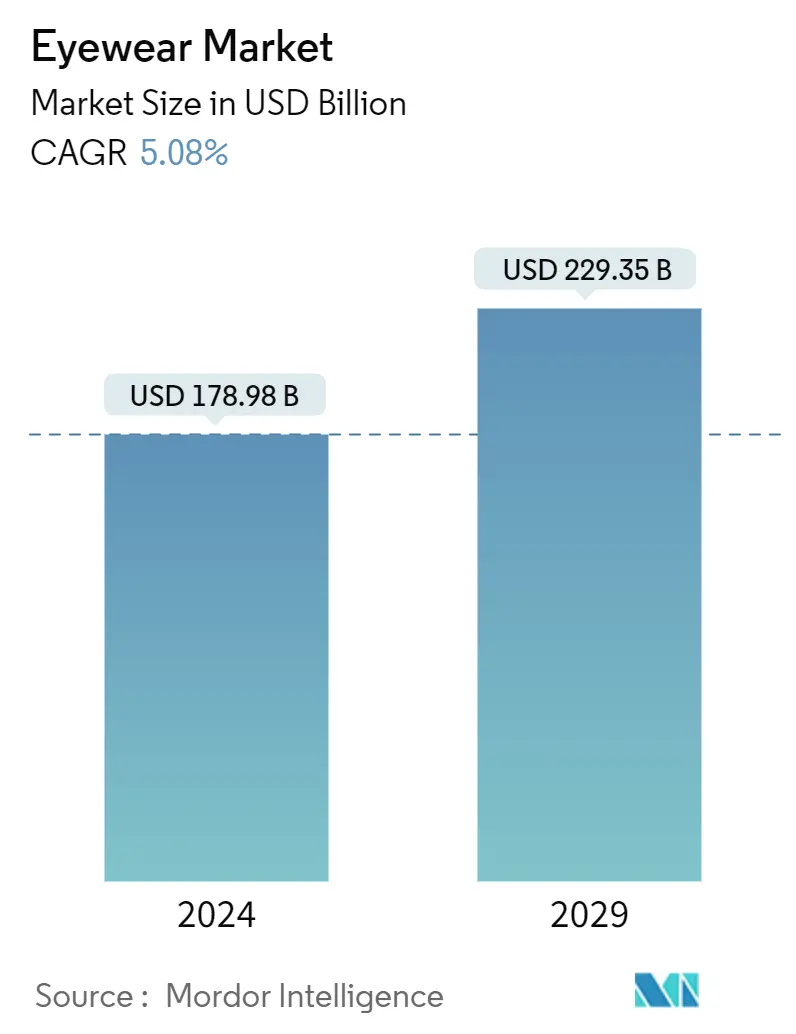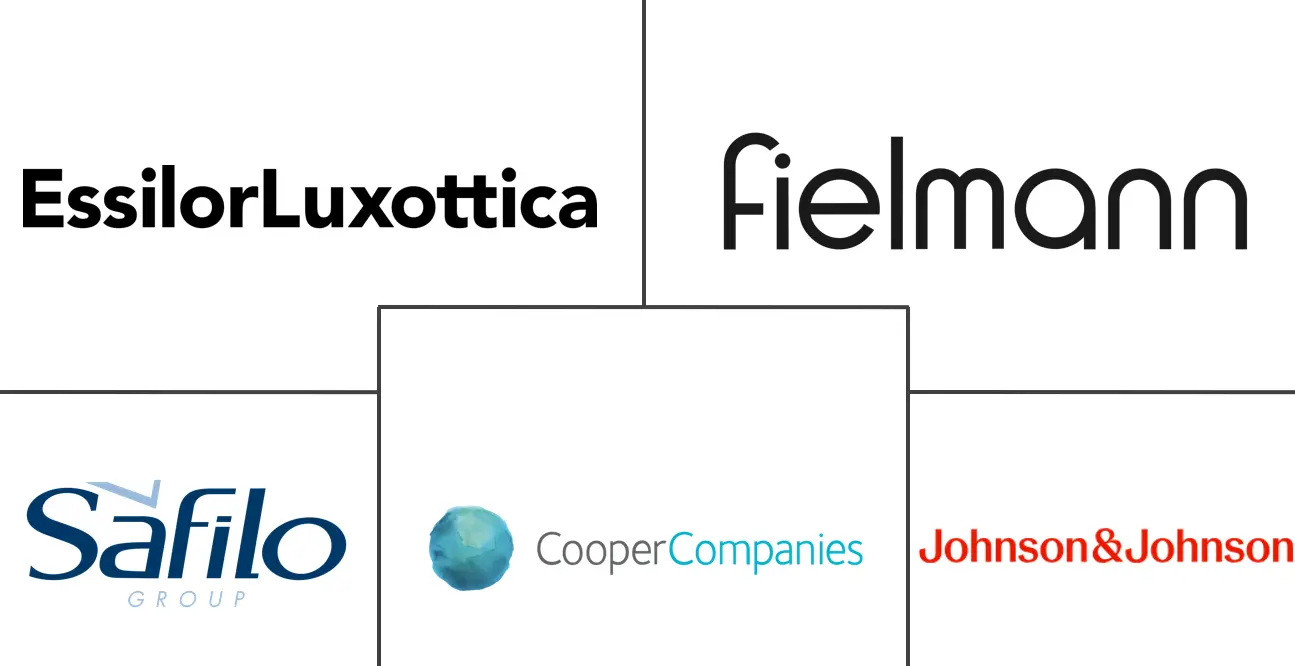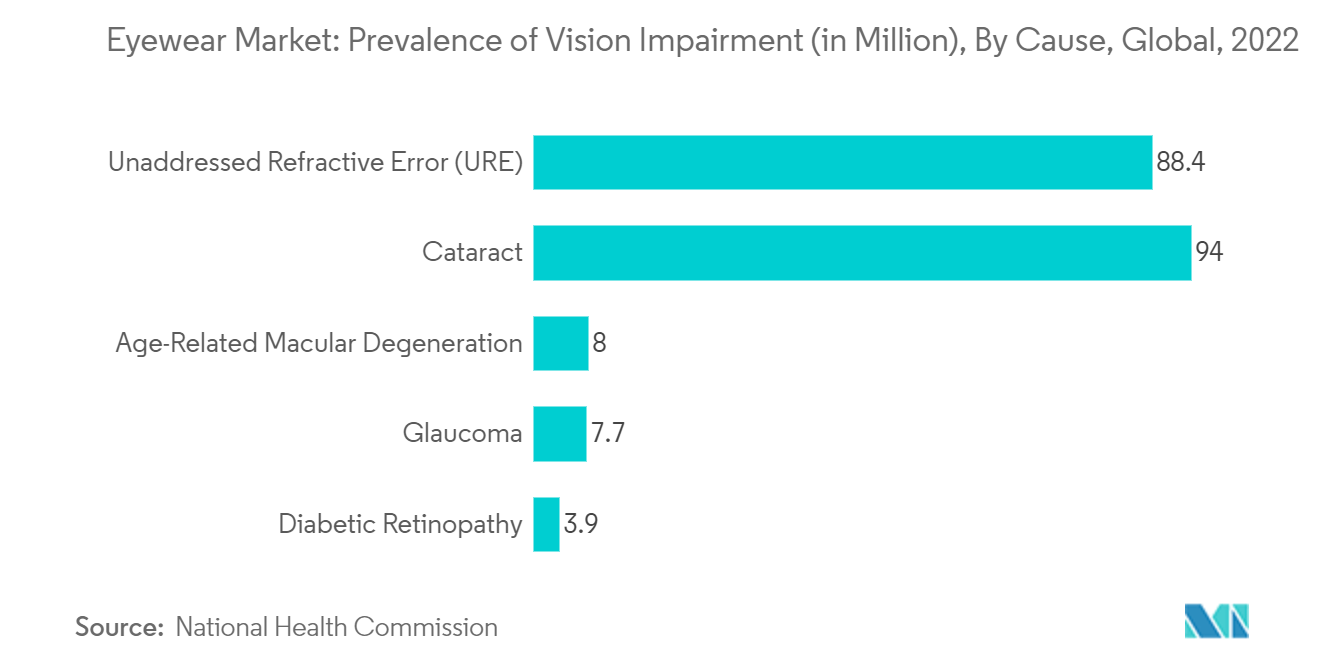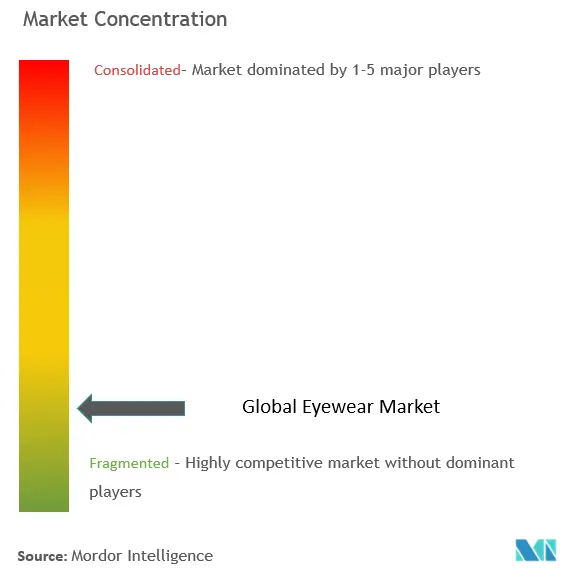Eyewear Market Size

| Study Period | 2019-2029 |
| Market Size (2024) | USD 178.98 Billion |
| Market Size (2029) | USD 229.35 Billion |
| CAGR (2024 - 2029) | 5.08 % |
| Fastest Growing Market | Asia-Pacific |
| Largest Market | Asia-Pacific |
Major Players
*Disclaimer: Major Players sorted in no particular order |
Eyewear Market Analysis
The Eyewear Market size is estimated at USD 178.98 billion in 2024, and is expected to reach USD 229.35 billion by 2029, growing at a CAGR of 5.08% during the forecast period (2024-2029).
The global eyewear market is propelled by the growing demands for corrective and prescription-based spectacles, especially among the geriatric population. For instance, the survey study of National Health and Ageing Trends conducted in the United States in 2021 states that 27.8% of United States adults aged above 71 years had vision Impairment. Thus, the higher prevalence of vision impairment among older age is raising the demand for spectacles in the market. Furthermore, an increase in consumer awareness regarding eye protection coupled with a rise in disposable income fuels the sunglasses market significantly. Moreover, the increasing demand for fashionable accessories among the young population is another major factor driving the growth of sunglasses in eyewear during the forecast period.
Over the past few years, the market studied has been witnessing a growing adaptation rate based on factors such as a rise in interest among consumers in opting for performance-oriented sunglasses due to the adoption of sunglasses for outdoor activities, inclusive of mountain biking, rock climbing, golfing, and inline skating, among others. For instance, according to the Outdoor Foundation, over 64 million people participated in outdoor activities in the United States in 2021, with hiking being the most popular. E-retailing and online advertising are gaining popularity in the market as key players are implementing online marketing and promotional activities. Online marketing and promotion provide customers with easy access and also help vendors reduce operational costs. This factor is expected to boost eyewear sales through online platforms over the coming years.
Eyewear Market Trends
Growing Popularity of Sports Sunglasses
In the past decade, the prevalence of vision impairment has been higher among all age groups of the population owing to several factors, such as the development of cataracts, uncorrected refractive error (URE), and age-related macular degeneration (ARMD). According to World Health Organization data published in 2022, nearly 2.2 billion people have near or distant vision impairment globally. Thus, the higher incidence of optical deficiencies is further raising the demand for eyewear such as spectacles and contact lenses in the market. Similarly, visual impairment disproportionately affects the elderly. With advancing age, the normal function of eye tissues decreases, and there is an increased incidence of ocular pathology. The high prevalence rate of diseases, such as diabetes and hypertension, owing to lifestyle conditions is further known to aggravate the rates of blindness and visual impairment. The accelerating degradation of eyes is boosting the market sentiments of eyewear products.
On the other hand, factors such as increasing acute myopia at a younger age, increasing awareness, and growing middle class and rising disposable incomes are expected to contribute to sustained demand for the eyewear market over the forecast period. For instance, a study about the prevalence of myopia among children in China published by the National Health Commission in 2020 shows that 71.1% of middle school students and 80.5% of high school students have myopia. To rectify the deficiency, spectacles and contact lenses are widely used, propelling the growth of the market studied. The global marketplace has also witnessed a significant increase in the “capture rate” among adults, indicating a higher number of eye tests, which are converted into sales of eyewear products. In developed countries, around 70% of adults require corrective lenses to achieve proper eyesight. Thereby, the rising prevalence of various types of optical deficiency across the global population is accelerating the growth of eyewear products in the market.

Asia-Pacific Likely to Experience the Highest Growth
A paradigm shift has been observed in Asia-Pacific, where the consumer perception of eyewear is changing from function to fashion. Consumers in the region are buying eyewear as a fashion statement. This is attributed to the growing economy and increasing purchasing power. China is the world's leading manufacturer of spectacles and has the largest potential consumer base. It also has the highest population rate with myopia, suggesting a huge potential for the spectacles market. According to the National Health Commission, Chinese children and teenagers overall had a short-sightedness rate of 52.7% in 2020. The prevalence of myopia and children's educational attainment were closely related. Less than 15% of children aged six had the disease, compared to one in three elementary school children and four out of five high school students.
The major racing events in Thailand are organized by different international organizers, such as L'Etape Thailand. Such events are augmenting the demand for sports sunglasses, which both domestic and international participants require. According to the National Statistical Office (Thailand), approximately 1.5 million Thai adults between the ages of 25 and 44 participated in regular exercise and sports in 2021. In the same year, about five million citizens of the nation participated in sports and got enough exercise. Moreover, the popularity of tourist-favored recreational pursuits like skiing and scuba diving impacts the demand for sports eyewear in the nation.

Eyewear Market Indsutry Overview
The market studied is fragmented. However, Safilo Group and Essilor International are experiencing an increase in their revenue share across developing economies. Product innovation and development, followed by partnerships, joint ventures, and expansion, are some of the strategies utilized by key players. Moreover, companies are investing significantly in technology-based innovative solutions through new ventures, partnerships, or acquisitions. The top players in the global eyewear market include Safilo Group SpA, De Rigo Vision SpA, Fielmann AG, EssilorLuxottica SA, and Johnson & Johnson Services Inc. Under a multi-year licensing agreement, Luxottica Group partnered with Ferrari SpA for the design, manufacturing, distribution, and sales of a range of eyewear products under the Ferrari and Ray-Ban brands.
Eyewear Market Market Leaders
-
Safilo Group S.p.A.
-
Fielmann AG
-
EssilorLuxottica SA
-
Johnson & Johnson Services, Inc.
-
The Cooper Companies, Inc.
*Disclaimer: Major Players sorted in no particular order

Eyewear Market News
- January 2024: Pair Eyewear, the direct-to-consumer customizable eyewear brand, unveiled a new partnership with National Vision Inc., the second-largest optical retailer in America. The brand stated that this partnership helps introduce affordable bundles, including Pair’s customizable, stylish, and accessible eyewear.
- September 2023: Ray Ban partnered with EssilorLuxottica to launch a new generation of Ray-Ban Meta smart glasses. As per the brand's claim, the new glasses feature improved audio and cameras, over 150 different custom frames and lens combinations, and are lighter and more comfortable.
- March 2022: Web Eyewear launched a collection of sunglasses for the Spring-Summer 2021 season inspired by two innovative concepts reflected in frames with a contemporary attitude.
Eyewear Market Report - Table of Contents
1. INTRODUCTION
- 1.1 Study Deliverables and Study Assumptions
- 1.2 Scope of the Study
2. RESEARCH METHODOLOGY
3. EXECUTIVE SUMMARY
4. MARKET DYNAMICS
- 4.1 Market Drivers
- 4.2 Market Restraints
-
4.3 Porter's Five Forces Analysis
- 4.3.1 Threat of New Entrants
- 4.3.2 Bargaining Power of Buyers/Consumers
- 4.3.3 Bargaining Power of Suppliers
- 4.3.4 Threat of Substitute Products
- 4.3.5 Intensity of Competitive Rivalry
5. MARKET SEGMENTATION
-
5.1 Product Type
- 5.1.1 Spectacles
- 5.1.2 Sunglasses
- 5.1.3 Contact Lenses
- 5.1.4 Other Product Types
-
5.2 End User
- 5.2.1 Men
- 5.2.2 Women
- 5.2.3 Unisex
-
5.3 Distribution Channel
- 5.3.1 Offline Channel
- 5.3.2 Online Channel
-
5.4 Geography
- 5.4.1 North America
- 5.4.1.1 United States
- 5.4.1.2 Canada
- 5.4.1.3 Mexico
- 5.4.1.4 Rest of North America
- 5.4.2 Europe
- 5.4.2.1 Spain
- 5.4.2.2 United Kingdom
- 5.4.2.3 Germany
- 5.4.2.4 France
- 5.4.2.5 Italy
- 5.4.2.6 Russia
- 5.4.2.7 Rest of Europe
- 5.4.3 Asia-Pacific
- 5.4.3.1 China
- 5.4.3.2 Japan
- 5.4.3.3 India
- 5.4.3.4 Australia
- 5.4.3.5 Rest of Asia-Pacific
- 5.4.4 South America
- 5.4.4.1 Brazil
- 5.4.4.2 Argentina
- 5.4.4.3 Rest of South America
- 5.4.5 Middle East and Africa
- 5.4.5.1 South Africa
- 5.4.5.2 Saudi Arabia
- 5.4.5.3 Rest of Middle East and Africa
6. COMPETITIVE LANDSCAPE
- 6.1 Market Share Analysis
- 6.2 Most Adopted Strategies
-
6.3 Company Profiles
- 6.3.1 Fielmann AG
- 6.3.2 Safilo Group SpA
- 6.3.3 EssilorLuxottica SA
- 6.3.4 The Cooper Companies Inc.
- 6.3.5 Johnson & Johnson Services Inc.
- 6.3.6 De Rigo Vision SpA
- 6.3.7 Carl-Zeiss-Stiftung
- 6.3.8 Charmant Group
- 6.3.9 Alcon Laboratories Inc.
- 6.3.10 Burberry Group PLC
- 6.3.11 Bausch Health Companies Inc.
- *List Not Exhaustive
7. MARKET OPPORTUNITIES AND FUTURE TRENDS
** Subject To AvailablityEyewear Market Indsutry Segmentation
Eyewear consists of accessories worn over the eyes to correct vision or protect the eyes from debris, radiation, or excessive light. The global eyewear market is segmented by product type, end-user, distribution channel, and geography. By product type, the market is segmented by spectacles, sunglasses, contact lenses, and other protective eyewear that comprises different lens materials. By end users, the market is segmented into men, women, and unisex. Based on distribution channels, the market is segmented into offline channels and online channels. By geography, the market is segmented into North America, Europe, Asia-Pacific, South America, and Middle East and Africa. The report offers the market size in value terms in USD for all the abovementioned segments.
| Product Type | Spectacles | |
| Sunglasses | ||
| Contact Lenses | ||
| Other Product Types | ||
| End User | Men | |
| Women | ||
| Unisex | ||
| Distribution Channel | Offline Channel | |
| Online Channel | ||
| Geography | North America | United States |
| Canada | ||
| Mexico | ||
| Rest of North America | ||
| Geography | Europe | Spain |
| United Kingdom | ||
| Germany | ||
| France | ||
| Italy | ||
| Russia | ||
| Rest of Europe | ||
| Geography | Asia-Pacific | China |
| Japan | ||
| India | ||
| Australia | ||
| Rest of Asia-Pacific | ||
| Geography | South America | Brazil |
| Argentina | ||
| Rest of South America | ||
| Geography | Middle East and Africa | South Africa |
| Saudi Arabia | ||
| Rest of Middle East and Africa |
Eyewear Market Research FAQs
How big is the Eyewear Market?
The Eyewear Market size is expected to reach USD 178.98 billion in 2024 and grow at a CAGR of 5.08% to reach USD 229.35 billion by 2029.
What is the current Eyewear Market size?
In 2024, the Eyewear Market size is expected to reach USD 178.98 billion.
Who are the key players in Eyewear Market?
Safilo Group S.p.A., Fielmann AG, EssilorLuxottica SA, Johnson & Johnson Services, Inc. and The Cooper Companies, Inc. are the major companies operating in the Eyewear Market.
Which is the fastest growing region in Eyewear Market?
Asia-Pacific is estimated to grow at the highest CAGR over the forecast period (2024-2029).
Which region has the biggest share in Eyewear Market?
In 2024, the Asia-Pacific accounts for the largest market share in Eyewear Market.
What years does this Eyewear Market cover, and what was the market size in 2023?
In 2023, the Eyewear Market size was estimated at USD 169.89 billion. The report covers the Eyewear Market historical market size for years: 2019, 2020, 2021, 2022 and 2023. The report also forecasts the Eyewear Market size for years: 2024, 2025, 2026, 2027, 2028 and 2029.
What are the key factors driving the Eye Wear Market?
The key factors driving the Eyewear Market are a) Growing number of ophthalmic disorders b) Increasing awareness regarding eye examinations c) Perception of eyewear as a fashion accessory
Eyewear Industry Report
The global eyewear market is characterized by a significant market size, driven by increased awareness of ocular diseases and evolving fashion trends. The market is segmented by product type, including spectacles, sunglasses, and contact lenses, catering to the needs of both vision correction and UV protection. North America dominates this market, but the reach is expanding globally, thanks to innovations such as 3D printing and the influence of social media influencers.
The market segmentation also includes end users categorized as men, women, and unisex, and is distributed through both offline and online channels. Despite facing challenges from cheaper alternatives and limited luxury eyewear penetration, the spectacles segment continues to lead the market. This growth is supported by both retail and growing online sales channels.
Industry statistics reveal that the eyewear market has a robust market share, bolstered by strategic mergers and acquisitions. The market forecast suggests continued growth, driven by industry trends and market predictions. Detailed industry analysis and industry reports provide a comprehensive market overview and market outlook, illustrating the market value and market growth potential.
The eyewear market also benefits from extensive market research, which helps identify target markets and industry growth opportunities. The industry information available through various industry reports and market reports offers valuable insights into the market data and market segmentation. This market analysis is crucial for understanding the market leaders and their strategies.
In conclusion, the eyewear market is poised for significant growth, with a positive industry outlook and promising market forecast. The market review and industry research highlight the potential for continued expansion and innovation in this dynamic industry.



